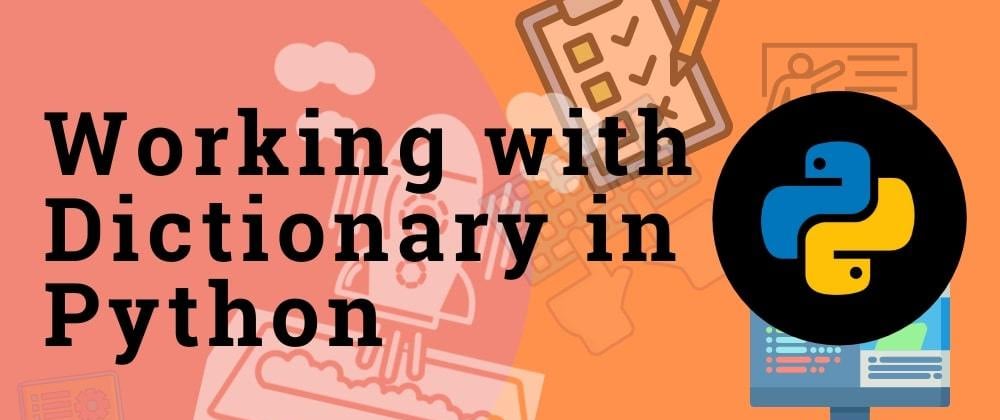In Python, dictionaries are associative arrays which store values in the form of 'key' and 'value' pair. Dictionaries are completely different from list and tuples as they are automatically indexed and only values are provided by the user.
But in the dictionary, we can provide both key and value. which means we can alter, modify and delete dictionary and its key, values.
Example : To creating empty dictonary use {} or we can use dictonary constructor 'dict()'.
d = {}
di = dict()
print(d)
print(di)
#PYTHON OUTPUT
{}
{}
Example: To add values in dictionary
d = {
'user_id' : 1,
'username' : 'Jake',
'age' : 25,
'salary' : 95000.75,
}
di = dict(
user_id=2,
username='Sushant',
age=29,
salary=105000.50
)
print('Dictonary using curly brackets')
print(d)
print('n') #next line
print('Dictonary using dict constructor')
print(di)
#PYTHON OUTPUT
Dictonary using curly brackets
{'user_id': 1, 'username': 'Jake', 'age': 25, 'salary': 95000.75}
Dictonary using dict constructor
{'user_id': 2, 'username': 'Sushant', 'age': 29, 'salary': 105000.5}
Example: Values from dictionary can be accessed using keys or by get() method
d = {
'user_id' : 1,
'username' : 'Jake',
'age' : 25,
'salary' : 95000.75,
}
print(d['username'])
print(d.get('username'))
#PYTHON OUTPUT
Jake
Jake
Example: Updating values in dictionary.
d = {
'user_id' : 1,
'username' : 'Jake',
'age' : 25,
'salary' : 95000.75,
}
d['username']='Rohit'
print(d['username'])
#PYTHON OUTPUT
Rohit
Appending new item in dictionary can be achieved by simply giving the name of key and value and it will be added in the bottom of dictionary.
Syntax:
dict['key'] = 'value'
Example
d = {
'user_id' : 1,
'username' : 'Jake',
'age' : 25,
'salary' : 95000.75,
}
d['date_of_birth'] = '1990-03-22'
print(d)
#PYTHON OUTPUT
{'user_id': 1, 'username': 'Jake', 'age': 25, 'salary': 95000.75, 'date_of_birth': '1990-03-22'}
There are various method to remove a item from dictionary
- Use
delkeyword by calling dictionary with a key name to delete. This will delete the item completely. - Use
pop()method by specifying key name inside parentheses.
Syntax
dict.pop('key_name')
- Use
popitem()this will remove the last key and value from Dictionary.
Syntax
dict.popitem()
Example
d = {
'user_id' : 1,
'username' : 'Jake',
'age' : 25,
'salary' : 95000.75,
}
del d['username'] #key 'username' will be removed from dictonary
print(d)
#PYTHON OUTPUT
{'user_id': 1, 'age': 25, 'salary': 95000.75}
Example : remove use pop() method.
d = {
'user_id' : 1,
'username' : 'Jake',
'age' : 25,
'salary' : 95000.75,
}
d.pop('username')
print(d)
#PYTHON OUTPUT
{'user_id': 1, 'age': 25, 'salary': 95000.75}
Example : remove using 'popitem()' method.
d = {
'user_id' : 1,
'username' : 'Jake',
'age' : 25,
'salary' : 95000.75,
}
d.popitem() #this method will remove the last item from dictonary in this case it is 'salary'
print(d)
#PYTHON OUTPUT
{'user_id': 1, 'username': 'Jake', 'age': 25}
To empty dictonary use clear() method.
Syntax
dict.clear()
Example
d = {
'user_id' : 1,
'username' : 'Jake',
'age' : 25,
'salary' : 95000.75,
}
d.clear()
print(d)
#PYTHON OUTPUT
{} #we get the empty dictonary
To delete dictionary completely use del keyword before dictionary variable.
d = {
'user_id' : 1,
'username' : 'Jake',
'age' : 25,
'salary' : 95000.75,
}
del d
print(d)
#PYTHON ERROR OUTPUT
NameError: name 'd' is not defined #because we have deleted the dictonary
Check if a key exists in dictionary
d = {
'user_id' : 1,
'username' : 'Jake',
'age' : 25,
'salary' : 95000.75,
}
if 'username' in d:
print('Exits')
else:
print('Does not exits')
#PYTHON OUTPUT
Exits
To check if a given value exists in dictionary use values() method.
Example
d = {
'user_id' : 1,
'username' : 'Jake',
'age' : 25,
'salary' : 95000.75,
}
if 'Jake' in d.values():
print('Exits')
else:
print('Does not exits')
#PYTHON OUTPUT
Exits
Example: To count the number of items present in dictionary use len() method.
d = {
'user_id' : 1,
'username' : 'Jake',
'age' : 25,
'salary' : 95000.75,
}
print(len(d))
#PYTHON OUTPUT
4
This article was taken from Working with Dictionary in Python







Top comments (0)